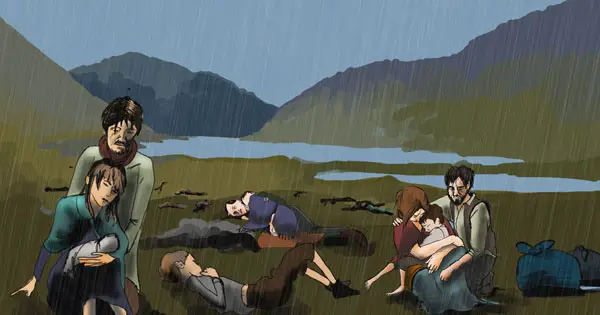The Doolough Tragedy is one of the most heart wrenching episodes in Irish history. Even by the standards of the Great Famine – the events at Doolough were particularly horrifying.
They resulted in the deaths of untold numbers of starving people who were treated with callous indifference by the very officials who were supposed to be helping them.
The tragedy happened in 1849 when Ireland’s poor were enduring their fourth year of hunger due to the loss of the potato crop and the failure of the government to provide adequate help.
Workhouses and government schemes were providing some relief, but it wasn’t nearly enough. To make things even more difficult for the starving, they had to submit themselves to inspection by government officials to prove that they really were destitute before they could qualify for the limited help available.
On March the 30th, 1849, two officials were due to assess the destitute people of Louisburg in County Mayo.
For reasons that that have never been fully uncovered, the meeting did not take place. Instead, the two officials made their way to spend the night at Delphi Lodge, 12 miles away.
The starving were told to report there for inspection at 7 o’clock the next morning or they would be struck off the list and get no support.
That meant they were obliged to walk through the night through the bitter March weather to be there on time. It would be a challenging 12-mile walk for the healthy and fully fit, but for people already weakened and debilitated by years of starvation, it was virtually impossible.
In spite of this they had no other choice but to attempt the journey. Reports from the time say it was freezing cold that night and heavy rain meant the route was extremely difficult. There was some flooding which meant the starving had to wade through water to continue their journey.
Not surprisingly, many didn’t make it and died along the way. There were reports of some people being blown by the high winds into the lough where they drowned or died from the cold.
The next day, the scene was described as a Trail of Corpses, and the dead had to be buried where they fell with little ceremony in graves so shallow they barely covered the bodies.
The exact number of casualties isn’t known, but some estimates put it at 600.
One of the surprising aspects of the story is how little attention was paid to it at the time. This is largely because so many people were dying that it hardly seemed remarkable, every town and village had a nightmare story of its own.
The Doolough Tragedy might never have come to anyone’s attention had it not been for a letter published in the Mayo Constitution newspaper on the fifth of April, 1849. (https://www.britishnewspaperarchive.co.uk/titles/mayo-constitution)
It was signed only as A Ratepayer and was addressed to the editor. These are some extracts.
Sir – On last Friday, 30th … the relieving officer, ordered the poor creatures forthwith to follow him to Delphi Lodge, as he would have them inspected early on the following morning, and in obedience of this order, hundreds of these unfortunate living skeletons, men, women and children, might have been seen struggling through the mountain passes and roads for the appointed place.
The inspection took place in the morning, and I have been told that nothing could equal the horrible appearance of those truly unfortunate creatures, some of them without a morsel to eat, and others exhausted from fatigue, having travelled upwards of 16 miles to attend the inspection.
I have now the melancholy duty of informing you and the public, that a woman named Dalton…her son and daughter, were all found dead on the road side, two men were found dead – in all, five.
The bodies of these ill-fated creatures lay exposed on the road side for three or four days and nights, for the dogs and ravens to feed upon, until some charitable person had them buried in a turf hole at the road side.
Now, Sir, I call upon you as the sincere friend of the poor, and in the name of the just God, to call upon the Lord Lieutenant of this country to demand a searching inquiry into this melancholy affair and prevent, if possible so many of the poor being sacrificed.
I am, Sir, your obedient servant, A RATEPAYER.
No such inquiry took place, the tragedy was merely brushed aside and nobody was called to account for what happened.
Now the only trace of the tragedy is the Doolough Valley Famine Memorial stone at the start of the Doolough Pass in the Delph Valley. It’s beautiful and serene to look upon today but was a death trap at the time of the walk.
The native American Choctaw Nation, who had their own Trail of Tears tragedy in 1830s, have also left a tribute.
The Famine Exhibition Centre at Louisburgh tells the full story of the Doolough Tragedy, and each year people gather from all over the world for the Doolough Famine Walk, which recreates the tragic journey in honour of the people who died in 1849.
The Doolough Tragedy Video
During the Irish Famine, hundreds of desperate, starving people were forced to walk 12 miles through the cold and rain at night to get help. Many died on the way.

